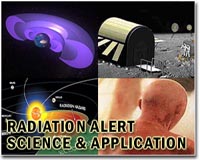 |
Los Angeles (AFP) March 14, 2011 California is closely watching the crisis at a Japanese nuclear plant, but officials downplayed the threat that a radioactive cloud blown across the Pacific could pose for the US West Coast. While radioactivity could reach the United States from the quake-hit Fukushima plant, the levels would not be high enough to cause major health problems, said the Nuclear Regulatory Commission (NRC). Some experts disagreed, notably pointing to the west-east jet stream, but NRC -- which was asked by Japan on Monday to send nuclear experts to deal with the crisis -- said even the Pacific island state of Hawaii faced little risk. "Right now it's quite possible that there could be some radiation floating over the United States. But we don't think that it would be particularly harmful... even in a worst case scenario," spokesman David McIntyre told AFP. The comments came as Japanese authorities grappled with multiple crises at the Fukushima No. 1 plant, 250 kilometers (155 miles) north of Tokyo, following Friday's 9.0 quake and tsunami in northeastern Japan. A third huge explosion rocked the plant Tuesday, while a spokesman said there appeared to be damage to the structure around the number-two reactor, while higher radiation levels were reported between Fukushima and Tokyo. California's Department of Public Health says it is "monitoring the situation closely," and highlights its Nuclear Emergency Response Program, which sets out measures to be taken in case of a nuclear incident. The western US state stockpiles emergency supplies including of potassium iodide (KI) tablets -- which can block some types of radiation -- in the area around the San Onofre nuclear power plant near San Diego, officials say. But the document is clearly designed for a possible radioactive leak from one of California's two nuclear plants -- including due to a long-feared major earthquake here -- rather than a threat from afar. Japan is more than 5,000 miles (8,000 kilometers) from the US West Coast, and nearer to Alaska in the north. Some experts suggest that, blown along by the fast-moving jet stream, radioactivity could reach North America in 36 hours. "Some of the radioactivity could carry in the atmosphere to the West Coast of the US," said nuclear expert Joe Cirincione, head of anti-nuclear group Ploughshares Fund. He cited the 1986 Chernobyl nuclear disaster to underline how far radioactivity can travel. "The radioactivity spread around the entire Northern Hemisphere," from the devastated Ukrainian plant, he said. Harvey Wasserman, a senior adviser to environmental group Greenpeace added that after Chernobyl "fallout did hit the jet stream and then the coast of California, thousands of miles away, within 10 days. "It then carried all the way across the northern tier of the United States," he continued. One climate expert used a modeling program from the National Oceanic and Atmospheric Administration (NOAA) to determine where the radioactivity would spread. "The great majority of these runs have taken plumes of radioactivity emitted from Japan's east coast eastwards over the Pacific, with the plumes staying over water for at least five days," said meteorologist Jeff Masters. "It is highly unlikely that any radiation capable of causing harm to people will be left in atmosphere after seven days and 2000+ miles of travel," added Masters, founder of the Weather Underground online weather forecasting service. "Even the Chernobyl nuclear disaster, which had a far more serious release of radioactivity, was unable to spread significant contamination more than about 1,000 miles," he said. The NCR spokesman declined to comment in depth on possible scenarios for how quickly or at what levels radioactivity could reach the US mainland. "Right now the government as a whole has people looking at the situation and asking these questions. We don't have the answers yet. We don't have anything that we can say publicly right now."
Share This Article With Planet Earth
Related Links Space Technology News - Applications and Research
 Report warns of wireless radiation risks
Report warns of wireless radiation risksBoulder, Colo. (UPI) Feb 3, 2011 A report in a U.S. journal says there are possible biological hazards and risks of genetic damage from unchecked proliferation of wireless technologies. A panel of international scientists writing in the journal Reviews of Environmental Health is urging world governments to set greatly reduced exposure limits for electromagnetic radiation from power line and telecommunications technolog ... read more |
|
| The content herein, unless otherwise known to be public domain, are Copyright 1995-2010 - SpaceDaily. AFP and UPI Wire Stories are copyright Agence France-Presse and United Press International. ESA Portal Reports are copyright European Space Agency. All NASA sourced material is public domain. Additional copyrights may apply in whole or part to other bona fide parties. Advertising does not imply endorsement,agreement or approval of any opinions, statements or information provided by SpaceDaily on any Web page published or hosted by SpaceDaily. Privacy Statement |